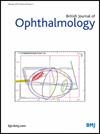Insights from 1096 clinical cases: pioneering a universal grading system for vernal keratoconjunctivitis management.
IF 3.7
2区 医学
Q1 OPHTHALMOLOGY
引用次数: 0
Abstract
AIM To analyse the clinical and demographic profiles of patients with vernal keratoconjunctivitis (VKC) and propose a grading for VKC based on corneal status and symptom periodicity rather than disease activity. METHODS Retrospective observational study from January 2015 to January 2020 in India. VKC grading was based on past/present clinical signs and frequency of symptoms rather than disease activity. The electronic medical records were screened and details of VKC patients diagnosed by cornea specialists were recorded and analysed. RESULTS 1096 VKC patients with a mean age of onset of 7.05±5.3 with 8.39% having adult onset were analysed. Symptoms included; itching (50.55%) and decreased vision (15.44%). Mixed VKC (52.04%) was the most common presentation with 49.1% having active disease. Complications included; keratoconus (18.43%), steroid-induced cataract (11.41%), glaucoma (10.95%) and limbal stem cell deficiency (5.29%). Dual-acting antiallergics (69.39%) were most commonly used, followed by topical immunomodulators.The patients were graded as, grade I: mild-presence of mild and seasonal symptoms and/or signs. Grade II: moderate-presence of persistent symptoms/and/or signs without corneal involvement. Grade III: severe-chronic persistent symptoms/and/or intermittent signs with corneal involvement or asymptomatic to mild symptoms with corneal pathognomonic signs. Grade IV: very severe-chronic persistent symptoms and/or corneal pathognomonic signs or active involvement/complication or asymptomatic with complications. CONCLUSION VKC is a chronic disease that often causes visual complications. The new grading system based on the cornea status and symptom periodicity rather than disease activity might help plan the management better.求助全文
约1分钟内获得全文
求助全文
来源期刊
CiteScore
10.30
自引率
2.40%
发文量
213
审稿时长
3-6 weeks
期刊介绍:
The British Journal of Ophthalmology (BJO) is an international peer-reviewed journal for ophthalmologists and visual science specialists. BJO publishes clinical investigations, clinical observations, and clinically relevant laboratory investigations related to ophthalmology. It also provides major reviews and also publishes manuscripts covering regional issues in a global context.

 求助内容:
求助内容: 应助结果提醒方式:
应助结果提醒方式:


